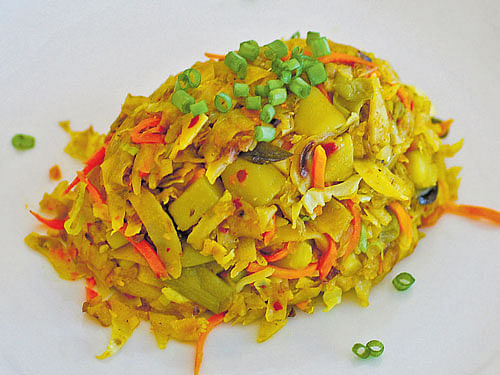Cinnamon. Cinnamon. Cinnamon. Does it sound like a random repetition? Not quite. If you are in Sri Lanka’s Hikka Tranz by Cinnamon that sits smug next to miles and miles of cinnamon plantation, where executive chef Julinda Pushpakumara throws cinnamon into cubed parow fish, you’d know you are in Indian Ocean’s teardrop, where spices run the kitchen and cinnamon is the monarch. Nutmeg. Pepper.
Chillies (60 kinds with varying degrees of fire!). Coriander. Sri Lankan cuisine is spiced enough for smoke to come out of your ears. I could recognise the spices, but the names on the menu seemed indecipherable — ambulthiyal, pachadi, tosai, kottu, kiribath, iddiyappam, wattalapan.
Sitting by the beach, Chef Julinda deciphers the indecipherable. Ambulthiyal is a sour, claypot fish curry; pachadi is cooked vegetable tossed in curd and freshly grated coconut, while tosai is slightly sour pancakes made with black gram and rice flour.
Kottu roti is the favourite fast food, kiribath is milk rice; iddiyappam are hoppers made with rice flour and coconut milk in a hemispherical wok. There’s a brown rice called kakulu. A treacle named kithul-palm. A seafood soup with a hip tag called Jaffna kool. Maldive fish is used as seasoning throughout the country. Of course, coconut is ubiquitous — grated, dessicated, coconut milk, coconut water — coconut is put to million uses here.
To each region, their ownEvery Sri Lankan will give his or her own 10 must-eats in the island where food flavours change according to the region. If your Sri Lankan curry is darker in shade, think of it as low-country dish — the colour comes from more pepper. The reddish curries are more upcountry, where chilli is used more than pepper. Coastal regions thrive on seafood, while the more inland regions subsist on vegetables and meat.
Negombo is famous for seafood, Kandy for vegetarian dishes where young jackfruit, jackfruit seeds, breadfruit and green papaya are commonly used and edible flowers like hibiscus, turmeric might end up in an omelette or curry.
When in Sri Lanka, think rice. The locals can eat rice for all the three meals. Hoppers (made of rice flour and coconut milk) for breakfast, rice with curry for lunch and more rice with more curry for dinner. The only roti dish that finds ready mention is the kottu roti (kottu), a dish prepared by chopping roti on a flat top along with meat, vegetables, eggs, resulting in a fried-rice-like dish, roti replacing the rice.
Influenced by...
With Buddhism being the dominant faith, Sri Lankans traditionally were vegetarians. However, with Dutch, British and Portuguese occupation, Sri Lankan cuisine assimilated varied flavours over centuries. But the biggest influence has been Indian cuisine. It is not surprising that the less-discerning foodie often ends up thinking of Sri Lankan cuisine as
‘Indian, sort of’. The popular Tamil dishes in Sri Lanka include rasam, Jaffna kool, pachadi and tosai.
The Portuguese introduced chilli before which Sri Lankans depended on pepper for food heat. The Portuguese influence continues even today, but exclusively in the area of rice cakes, bolo de coco (coconut cake), foguete (deep fried pastry tubes with sweet filling) and bolo folhado (layered cake).
As I moved up north towards Beruwala, the landscape changed its hues, the streets flanked by locals selling king coconut, the orange raw coconut. In Bufe at Cinnamon Bey, Chef Prageeth Wijesinghe took me on a dessert detour, a tradition that comes from the European — and Malay — influence.
Watallapan resembles a flan, but is made with coconut milk and jaggery; halapa, a mix of red millet flour, coconut flour, and jaggery wrapped in a leaf and steamed. Everyone’s everyday favourite is the curd plus treacle. This is not yogurt in plastic cups picked off the supermarket shelf. Curd is only made of water buffalo milk, left to settle in clay pots over-
night and served with treacle, the sap of kithul palm.
Recipe
Pol sambol
Ingredients:
Dried chilli: 1 tbsp
Finely chopped onion: 1 tbsp
Pepper: 1 tbsp
Ground Maldive fish: 1 tbsp
Freshly grated coconut: 500 gmn Lime juice: 3 tbsp
Salt: to taste
Method: Grind together chilli, onion, pepper and Maldive fish. Add grated coconut, season with lime juice.
